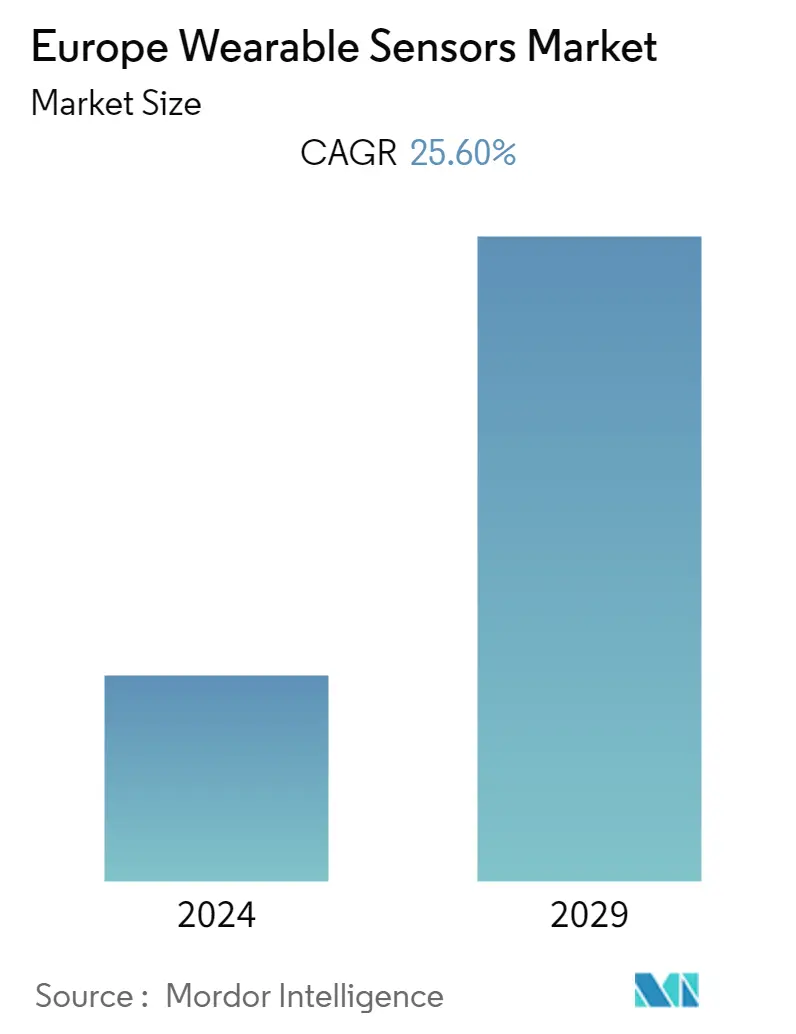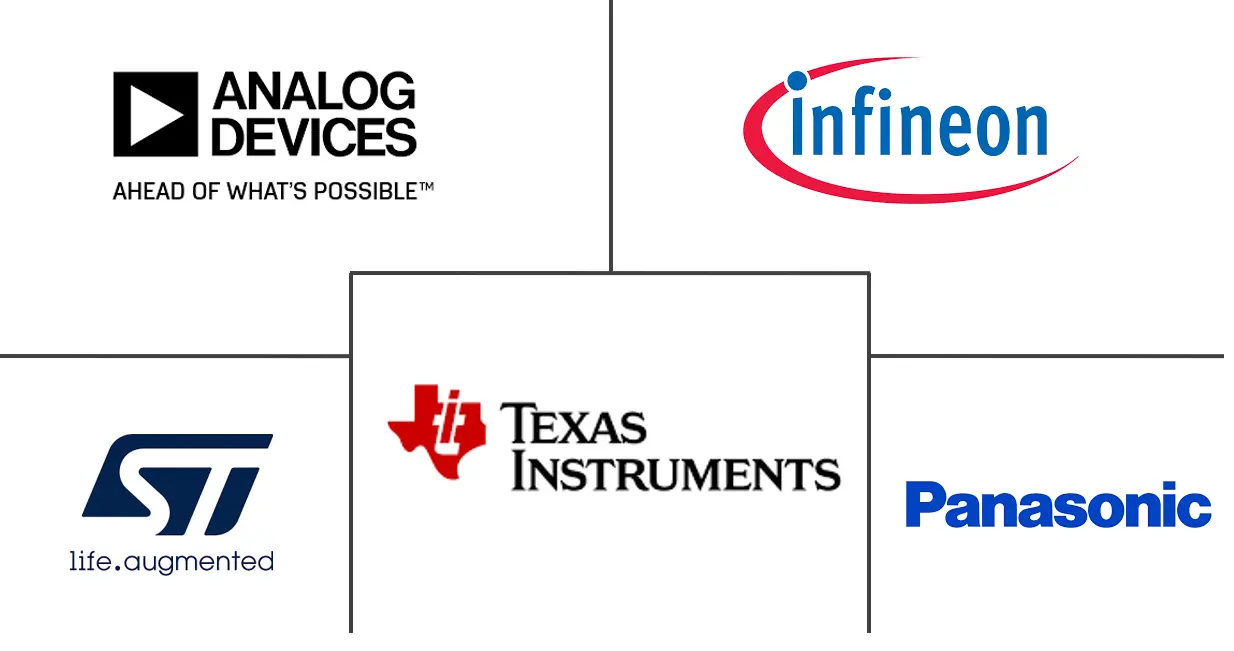Market Size of Europe Wearable Sensors Industry

| Study Period | 2019 - 2029 |
| Base Year For Estimation | 2023 |
| Forecast Data Period | 2024 - 2029 |
| Historical Data Period | 2019 - 2022 |
| CAGR | 25.60 % |
| Market Concentration | Medium |
Major Players
*Disclaimer: Major Players sorted in no particular order |
Europe Wearable Sensors Market Analysis
The Europe Wearable Sensor Market is expected to register a CAGR of 25.6% during the forecast period 2021 - 2026. Wearable Sensors are a type of sensors that are an integral part of the wearable devices attached to the body or the clothing.
- In Europe, wearable sensors are being used in various domains such as healthcare, sports, and fitness, defense, travel, etc. These sensors have been used in the military for various applications like a heads-up display. These sensors are being adopted in cinemas, gaming, and flight simulator in the entertainment industry.
- The wearable sensors market is helping the augmented reality market in entertainment. Products like Oculus Rift and Sony HMZ-T3Q are gaining a lot of popularity among gamers, and Europe is a big gaming market.
- Moreover, consumers in the UK have adopted wearable technology enthusiastically, particularly fitness trackers, becoming an increasingly commonplace accessory on people's wrists. According to the Office for National Statistics (UK), the United Kingdom contains one of Europe's largest fitness markets, with total revenue of about EUR 5.3 billion. Since 2012 there has been a consistent increase in the number of fitness facilities in the UK. Such instances are expected to boost the growth of the European Wearable Sensor market.
- With the outbreak of COVID-19, several enterprises are expected to use contact tracking wearables. For instance, in May 2020, IoT connectivity and security startup Nodle, technology solutions company Avnet, and non-profit foundation Coalition Network announced the creation of a new smart wearable contact tracing device, the Nodle M1. Also, Nodle announced that it had already received interest from large enterprises in Europe for several million units.
Europe Wearable Sensors Industry Segmentation
In Europe, wearable sensors are being used in various domains such as healthcare, sports, and fitness, defense, travel, etc. Major companies in the market, Panasonic, Sony, Samsung, Motorola, Pebble, etc., are investing heavily in this technology. The studied report analyses the market with respect to the Type (Health Sensors, Environmental Sensors, MEMS Sensors, Motion Sensors), Device ( Wristwear, Bodywear & Footwear), Application and Geography of the area.
| By Type | |
| Health Sensors | |
| Environmental Sensors | |
| MEMS Sensors | |
| Motion Sensors | |
| Others |
| By Device | |
| Wristwear | |
| Bodywear and Footwear | |
| Others |
| By Application | |
| Health and Wellness | |
| Safety Monitoring | |
| Home Rehabilitation | |
| Others |
| By Country | |
| United Kingdom | |
| Germany | |
| France | |
| Others |
Europe Wearable Sensors Market Size Summary
The European wearable sensor market is experiencing robust growth, driven by its integration into various sectors such as healthcare, sports, fitness, defense, and entertainment. These sensors, which are essential components of wearable devices, are increasingly being adopted for applications ranging from military heads-up displays to augmented reality experiences in gaming. The market is further bolstered by the region's strong gaming industry and the widespread adoption of fitness trackers, particularly in the UK, which boasts one of Europe's largest fitness markets. The COVID-19 pandemic has also accelerated the demand for contact tracing wearables, highlighting the versatility and growing importance of wearable sensors in addressing contemporary challenges.
Technological advancements, such as the development of 5G networks, are expected to enhance the functionality and adoption of wearable sensors in Europe, particularly in business-to-business applications. Companies are investing in innovative solutions that integrate wearable technologies into various domains, including clinical systems, consumer electronics, and military applications. Notable developments include smart textiles and head-mounted displays, which are being explored for their potential in health monitoring and industrial applications. The market is moderately consolidated, with key players like STMicroelectronics and Semtech leading the charge in developing advanced sensor technologies. These trends indicate a promising outlook for the European wearable sensor market, with ongoing innovations poised to drive further growth.
Europe Wearable Sensors Market Size - Table of Contents
-
1. MARKET DYNAMICS
-
1.1 Market Overview
-
1.2 Industry Attractiveness - Porter's Five Force Analysis
-
1.2.1 Threat of New Entrants
-
1.2.2 Bargaining Power of Buyers
-
1.2.3 Bargaining Power of Suppliers
-
1.2.4 Threat of Substitute Products
-
1.2.5 Intensity of Competitive Rivalry
-
-
1.3 Market Drivers
-
1.3.1 Increasing applications in the industrial sector and improvement in the battery sizes.
-
1.3.2 Development of wearable sensor devices that look fashionable
-
-
1.4 Market Restraints
-
1.4.1 Reluctance from end users in employing new innovations due to their expensive nature
-
-
1.5 Industry Value Chain Analysis
-
1.6 Technology Snapshot
-
1.6.1 Key Technology Overview (MEMS, CMOS etc.)
-
-
-
2. MARKET SEGMENTATION
-
2.1 By Type
-
2.1.1 Health Sensors
-
2.1.2 Environmental Sensors
-
2.1.3 MEMS Sensors
-
2.1.4 Motion Sensors
-
2.1.5 Others
-
-
2.2 By Device
-
2.2.1 Wristwear
-
2.2.2 Bodywear and Footwear
-
2.2.3 Others
-
-
2.3 By Application
-
2.3.1 Health and Wellness
-
2.3.2 Safety Monitoring
-
2.3.3 Home Rehabilitation
-
2.3.4 Others
-
-
2.4 By Country
-
2.4.1 United Kingdom
-
2.4.2 Germany
-
2.4.3 France
-
2.4.4 Others
-
-
Europe Wearable Sensors Market Size FAQs
What is the current Europe Wearable Sensors Market size?
The Europe Wearable Sensors Market is projected to register a CAGR of 25.60% during the forecast period (2024-2029)
Who are the key players in Europe Wearable Sensors Market?
STMicroelectronics, Infenion Technologies AG, Texas Instruments Incorporated, Analog Devices Inc. and Panasonic Corporation are the major companies operating in the Europe Wearable Sensors Market.

